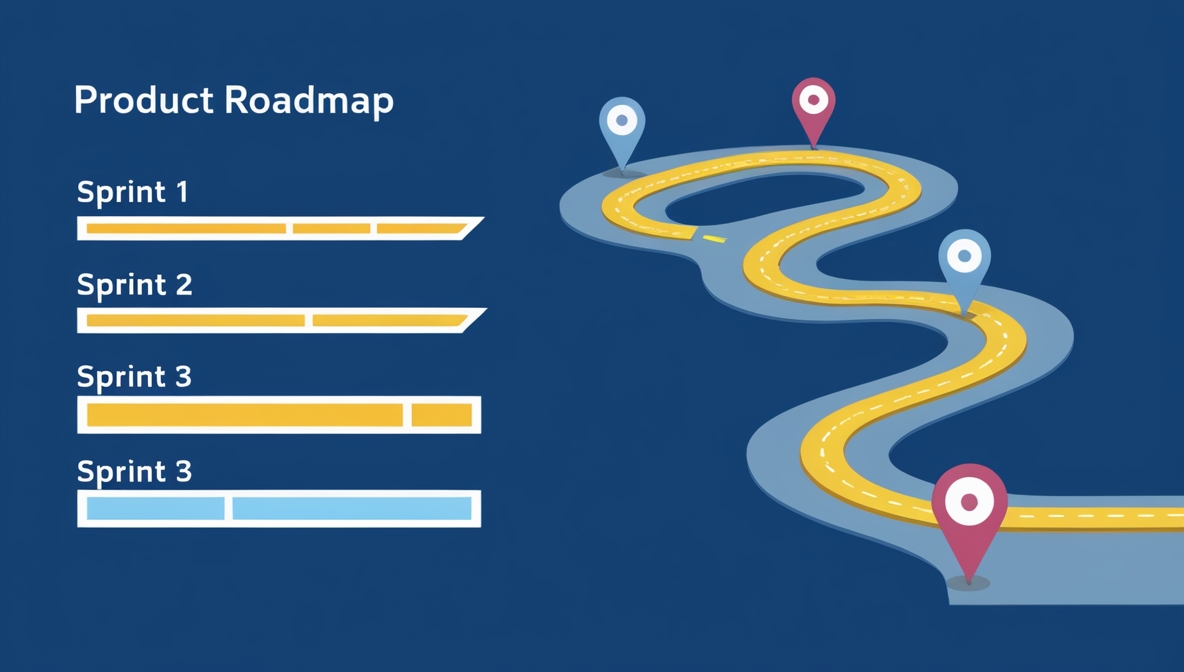A product roadmap serves as a strategic compass, guiding the direction and evolution of a product. It's more than just a feature list; it's a visual summary that encapsulates the product's vision, strategy, and key initiatives, often plotted over time. The roadmap acts as a communication tool, fostering alignment among internal stakeholders like executives, development teams, and marketing, while also providing transparency to external parties such as customers and partners.
The necessity of product roadmaps in product management stems from their ability to bridge the gap between strategic vision and tactical execution. In an increasingly agile world, where market demands and technological advancements necessitate adaptability, roadmaps provide a flexible framework for planning and prioritizing initiatives. They enable product managers to make informed decisions, allocate resources effectively, and ensure that the product's development aligns with the overarching business goals. The roadmap serves as a living document, facilitating ongoing discussions, adjustments, and communication, ultimately driving the product towards success in the marketplace.
Many product managers struggle with creating, planning, and communicating their product roadmaps effectively. They often find themselves overwhelmed by the sheer volume of data and requests from different departments, leading to confusion and misalignment. Without a clear roadmap, it becomes challenging to prioritize initiatives, allocate resources efficiently, and gain stakeholder buy-in, resulting in project delays and missed opportunities.
This challenge is further compounded by the dynamic nature of today’s markets, where customer needs and competitive landscapes can shift rapidly. Product managers need to be agile and adaptable, constantly revisiting and updating their roadmaps to reflect new information and changing priorities. The lack of a structured approach to roadmap creation and communication can lead to inefficiencies and miscommunication, hindering the product's success.
This guide to product roadmaps addresses these issues by providing a structured, step-by-step approach to roadmap planning and execution. It emphasizes the importance of aligning the roadmap with the overall business strategy, using goal-driven decision-making, and incorporating customer feedback. The guide also offers practical techniques for prioritizing initiatives, such as the Value vs. Complexity model and Weighted Scoring, to ensure that the most impactful projects are given precedence.
Main Contents
- Defining Product Roadmaps: Detailed explanation of what a product roadmap is, including its purpose and key components.
- Strategic Planning and Alignment: Methods for aligning the product roadmap with the overall business strategy and setting clear, strategic goals.
- Prioritizing Initiatives: Practical approaches for prioritizing initiatives, such as the Value vs. Complexity model and Weighted Scoring.
- Building and Communicating the Roadmap: Step-by-step guidance on creating a compelling roadmap and effective communication techniques to ensure stakeholder engagement.
- Examples and Best Practices: Real-world examples and best practices from experienced product managers to inspire and guide the roadmap creation process.
Key Takeaways
- Clear Vision and Strategy: A well-defined product roadmap articulates a clear vision and strategic direction, essential for guiding product development.
- Alignment with Business Goals: Successful roadmaps align closely with the overall business strategy, ensuring that product initiatives support organizational objectives.
- Effective Prioritization: Utilizing models like Value vs. Complexity helps prioritize initiatives that offer the highest impact and feasibility.
- Enhanced Stakeholder Communication: Effective communication of the roadmap ensures that all stakeholders are aligned and supportive of the product strategy.
- Adaptability and Agility: Treating the roadmap as a living document allows for flexibility and adaptability in response to changing market conditions and new information.
Although primarily aimed at product managers, offers a wealth of knowledge that CIOs and IT leaders can apply to their own domains. By adapting the principles of strategic alignment, prioritization, communication, and visual roadmapping, IT leaders can enhance their ability to plan, execute, and communicate technology initiatives effectively, ultimately driving business value and fostering innovation.
- Strategic Alignment: Emphasizes the importance of tying product roadmaps to overarching business strategies. CIOs can use this principle to ensure that IT initiatives are not just technically sound but also contribute to the organization's broader goals. The concept of defining clear product goals and metrics, as outlined in the guide, can be adapted to establish measurable objectives for IT projects, ensuring accountability and demonstrating value.
- Prioritization and Resource Allocation: Provides various prioritization techniques, such as the Value versus Complexity model and Weighted Scoring, which can aid CIOs in making informed decisions about resource allocation. These frameworks can help IT leaders evaluate competing projects, balance the need for innovation with operational requirements, and optimize the use of limited budgets and personnel.
- Effective Communication: Stresses the importance of clear and persuasive communication when presenting roadmaps to stakeholders. CIOs can utilize the communication strategies outlined in the guide to articulate the value of IT initiatives, secure executive buy-in, and manage expectations. The emphasis on visual roadmaps and tailoring communication to the audience can help IT leaders bridge the gap between technical complexities and business needs.
- Technology and Architecture Roadmaps: Provides specific examples of technology and architecture roadmaps, which can serve as templates for CIOs to visualize and communicate their IT strategies. These roadmaps can help IT leaders articulate their plans for infrastructure upgrades, system migrations, and other technology initiatives, ensuring transparency and alignment with business stakeholders.
- Enterprise IT Roadmaps: Addresses the challenges of managing IT initiatives in large enterprises. The concept of an enterprise IT roadmap can help CIOs visualize and prioritize strategic initiatives, ensuring that IT efforts are aligned with the organization's overall goals and compliance requirements.

